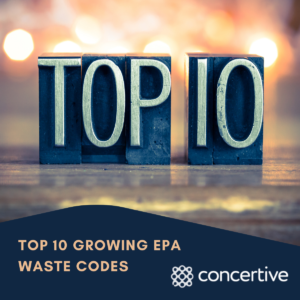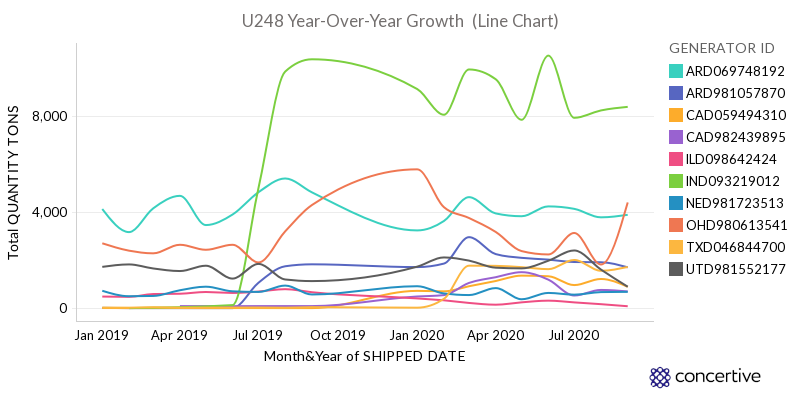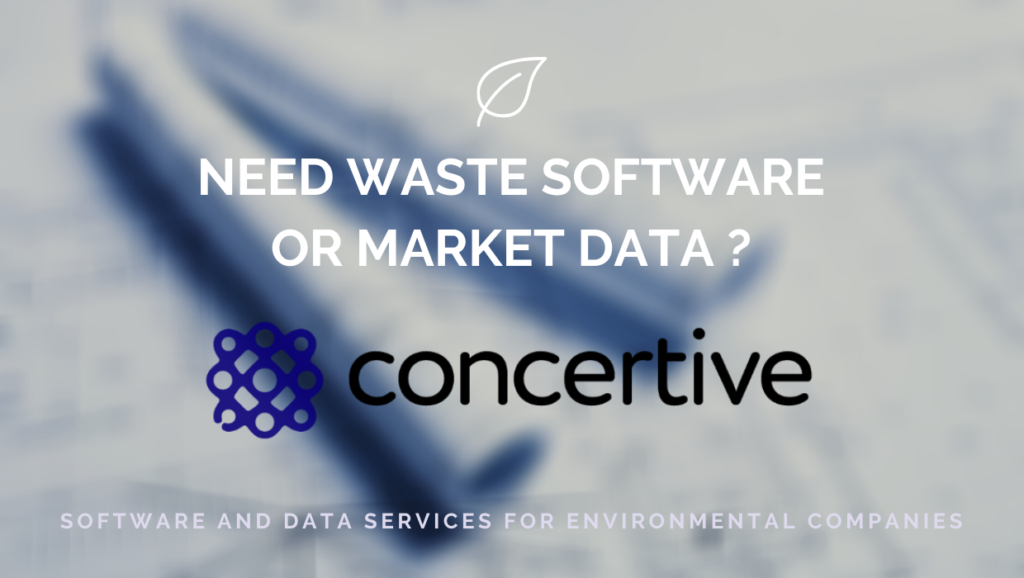
In this article we are going to look at the top 10 EPA waste codes with the most growth in 2020. To do this we will compare 2020 hazardous waste data with 2019 data from e-Manifest.
What Are EPA Waste Codes?
EPA waste codes explain the reason why your waste is hazardous. The code is linked to specific criteria and if you as a generator apply that code on a hazardous waste manifest or profile, you are saying that criteria applies. For more information about hazardous waste criteria, waste determination and EPA waste codes, visit or our in-depth article: What Is Hazardous Waste? You can also visit this page from EPA.
The “Sort of” Top 10 EPA Waste Codes With Largest Growth
The below chart shows the top 10 EPA waste codes unfiltered and sorted by year-over-year growth. However, if you are truly looking for the 10 waste codes that TRULY grew the most year-over-year…this list ain’t it. We’ll discuss why that is further into this article.
With e-Manifest data having a lag of around 90 days, this data covers through around mid-November 2020.
| 2020 | 2019 | |||
| FEDERAL WASTE CODE | DESCRIPTION | CHANGE IN TONS | TOTAL TONS | TOTAL TONS |
| U248 | 2H-1-Benzopyran-2-one, 4-hydroxy-3-(3-oxo-1-phenyl-butyl)-, & salts, when present at concentrations of 0.3% or less (Warfarin) | 98,602.8 | 233,214.1 | 134,611.3 |
| U173 | Ethanol, 2,2′-(nitrosoimino)bis- (N-itrosodiethanolamine) | 94,986.7 | 259,730.7 | 164,743.9 |
| U182 | Paraldehyde | 93,089.4 | 259,736.2 | 166,646.8 |
| K062 | Spent pickle liquor generated by steel finishing operations of facilities within the iron and steel industry (SIC Codes 331 and 332) | 89,039.4 | 283,418.6 | 194,379.2 |
| U136 | Arsinic acid, dimethyl-(Cacodylic acid) | 82,382.0 | 211,608.2 | 129,226.2 |
| U244 | Thioperoxydicarbonic diamide [(H2 N)C(S)]2 S2, tetramethyl- (Thiram) | 82,036.6 | 230,048.9 | 148,012.3 |
| U079 | 1,2-Dichloroethylene (Ethene, 1,2-dichloro-, (E)-) | 81,687.8 | 282,786.8 | 201,099.0 |
| U246 | Cyanogen bromide (CN)Br | 81,595.3 | 228,521.3 | 146,926.1 |
| U150 | Melphalan (L-Phenylalanine, 4-[bis(2-chloroethyl)amino]-) | 80,786.6 | 238,358.0 | 157,571.4 |
| U204 | Selenious acid (Selenium dioxide) | 80,454.6 | 229,341.4 | 148,886.8 |
Analysis of U248 (Warfarin) – EPA Waste Code With Largest Year-Over-Year Growth
Warfarin (Coumadin) is a blood thinner and is used to treat and prevent blood clots. Could the growth in volume be related to Covid, whether treatment or manufacture of a vaccine?
“U248” is specifically for dilute Warfarin streams (<= 0.3%), higher concentrations would carry a “P001” waste code. Could these volumes originate from rinsing and cleaning out manufacturing equipment involved in the manufacture of Warfarin?
Top 10 U248 Shippers in e-Manifest
Below are charts showing the volumes of U248 waste coming from the 10 largest shippers of that hazardous waste code.
Top 10 U248 Shippers 2019 – 2020 (Line Chart)
The below chart shows monthly volumes of U248 from 2019 through 2020. You can see a drastic jump in mid 2019 from one shipper.

Top 10 U248 Shipper Table
The below table shows the top 10 largest shippers of U248 with 2019 and 2020 volumes.
|
Notice anything that ALL of these shippers have in common?
THEY ARE ALL WASTE COMPANIES. You can see from the line chart that Heritage -Indianapolis is responsible for most of the YOY growth.
Our goal here is to try and find what wastes are growing in the US market. Why are there no chemical plants or pharmaceutical companies? You would assume that if disposal companies are shipping out more of this waste code their inbound receipt of this code would be up.
Let’s review that assumption and look at the largest U248 shippers to Heritage – Indianapolis.
U248 Shippers Into Heritage – Indianapolis (IND093219012)
The below charts show the top 10 largest shippers of U248 into Heritage – Indianapolis (the largest source of increase for this waste code in 2020.)

U248 Shippers Into Heritage – Indianapolis (IND093219012) Table
|
2020 Volumes are up approximately 3,000 tons for U248 into IND093219012 but almost all of that growth is intra-company waste. Externally generated volumes for this waste into IND093219012 are up only 100 tons. Not what we are looking for if we are searching for growth opportunities!
A deeper look at this wastestream shows this stream carrying numerous RCRA codes not just U248. Most likely this code was added to the facility’s bulk landfill profile to cover any instances where low levels of Warfarin could be commingled in the site’s outbound waste.
“Mixture Rule” for Listed Hazardous Wastes
Because of the “mixture rule” for listed hazardous wastes, any waste this U248 waste (and other listed hazardous wastes) mixes with must carry the “U248” code also.
For example, if a hazardous waste treatment facility accepted one drum with a U248 code and transferred this waste to a tank for wastewater treatment, all of the solids and material from that larger tank now carry the “U248” code. This is the reason hazardous waste companies are the largest shippers of this waste code.
We cover the mixture rule more in-depth in our article “What Is Hazardous Waste?“
How To Determine Our Real Top 10 EPA Waste Codes
The pattern of waste companies being the largest shippers holds true for most of the other top 10 codes. So, how do we find out what EPA waste codes are actually growing in our present market?
Analyze Largest Waste Codes Shipped from Non-Waste Management Companies
For our real top 10, we are going to exclude shipments from companies in the waste management industry and find out which codes have grown the most in 2020. We will do this by removing the “Waste Management and Remediation Services” Sub-Sector from our volumes.
The Top 10 EPA Waste Codes With Largest Growth
Below we have our top 10 hazardous waste codes that grew in 2020. This data contains hazardous waste volumes through around mid-November 2020 and removes volumes shipped from Waste Management companies.
| 2020 | 2020 | 2020 | ||
| FEDERAL WASTE CODE | DESCRIPTION | CHANGE IN TONS | TOTAL TONS | % CHANGE |
| D028 | 1,2-Dichloroethane | 23,161.8 | 59,711.3 | 63.4% |
| D043 | Vinyl chloride | 22,282.0 | 43,220.7 | 106.4% |
| K061 | Emission control dust/sludge from the primary production of steel in electric furnaces | 15,781.6 | 630,273.6 | 2.6% |
| K062 | Spent pickle liquor generated by steel finishing operations of facilities within the iron and steel industry (SIC Codes 331 and 332) | 14,538.7 | 32,947.9 | 79.0% |
| D040 | Trichloroethylene | 10,094.8 | 68,628.9 | 17.2% |
| U220 | Benzene, methyl- (Toluene) | 9,452.7 | 46,608.0 | 25.4% |
| D026 | Cresol | 7,285.9 | 44,055.9 | 19.8% |
| D003 | Reactivity | 6,736.1 | 123,923.3 | 5.7% |
| D038 | Pyridine | 5,810.1 | 56,784.2 | 11.4% |
| U239 | Benzene, dimethyl- (Xylene) | 5,799.6 | 27,000.0 | 27.4% |
Stay Tuned
We will look into what insights we can glean by examining the shippers and industries of these waste codes.
How We Get Our Data
All data and analytics comes from our Knowsys application which brings together numerous environmental, compliance and industry datasets for the most comprehensive, current and connected business intelligence application for solid and hazardous waste.
If you would like more information about Knowsys or other ways we can help your company, please contact us.

